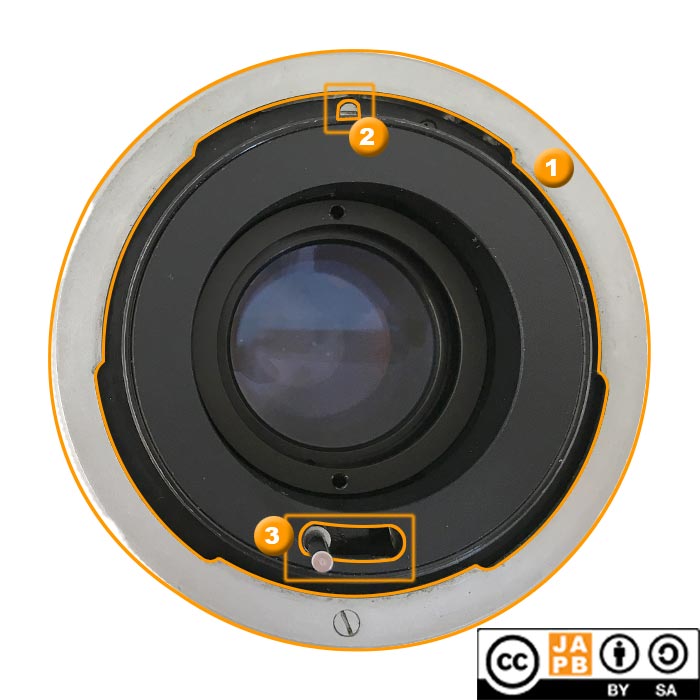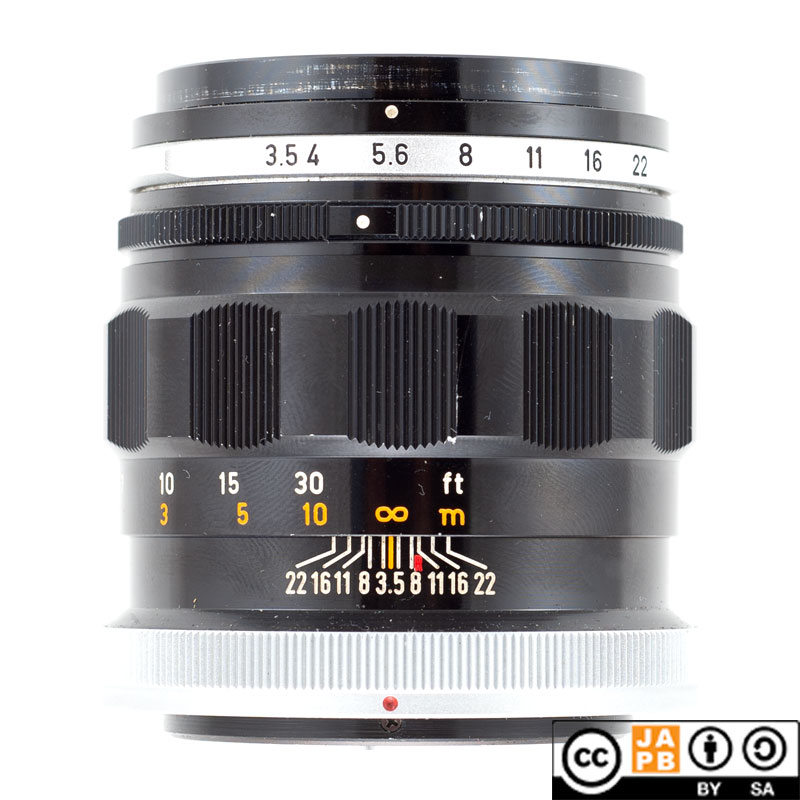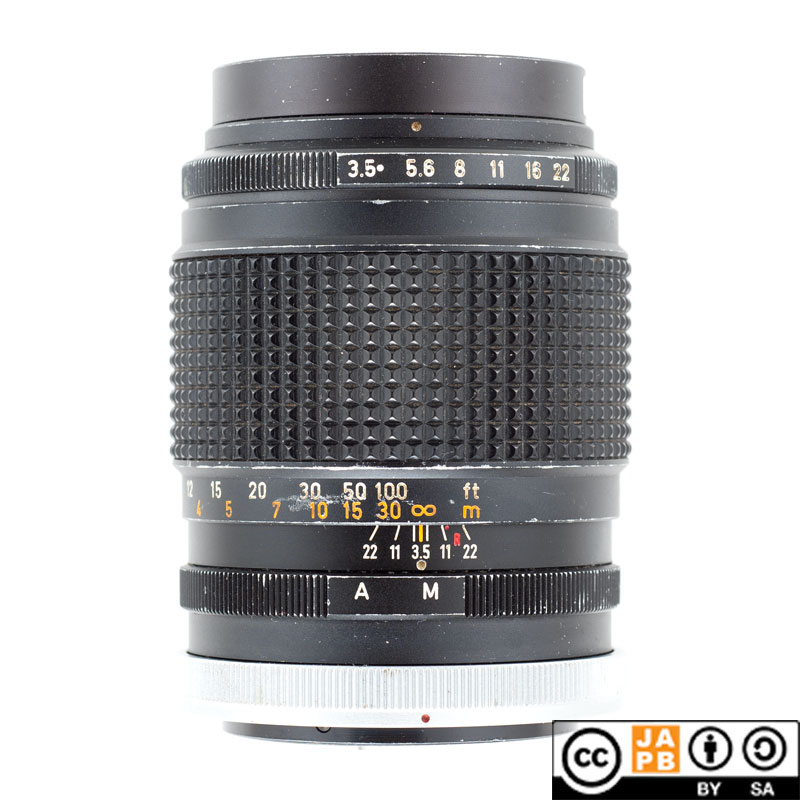Pekka Buttler 11/2025
Canon FL mount specifications and identification
Current: 1964–1971
Mount type: Breech lock (locking ring on lens)
Flange focal distance: 42 mm
Film format: 36mm x 24mm (‘Full frame’)
Mount communication: One lever for actuating aperture stop down at time of taking the shot (camera-to-lens)

Key characteristics of the mount of Canon FL lenses:
[1] Breech lock locking ring, rotates approximately 90 degrees (when not connected to a camera).
[2] Alignment pin.
[3] Stop-down lever.
Introduction
This article is about the Canon FL mount. The Canon FL mount is the direct successor of the Canon R mount and the direct predecessor of the Canon FD and Canon new FD (FDn) mounts. While there are several similarities between these mounts (and JAPB has previously treated them together), there are also significant differences and mount-specific quirks that merit giving each a separate treatment. Also, these three mounts and their details and significance cannot be adequately discussed in one readable-length article.
Before going further, it is worthwhile to note that the FL-mount is one in a long lineup of Canon interchangeable lens mounts for SLR’s. A short genealogy of the Canon SLR mounts is:
Canon R 1959–1963
Canon FL 1964–1968
(Canon EX 1969–1972)
Canon FD 1971–1979
Canon FDn 1979–1990
Canon AC 1985–1986
Canon EF 1987–2020
Canon EF-S 2003–2020
Canon EF-M 2012–2020
Canon RF 2018–today1
Back story
Let’s start back in 1964. At this stage Canon was – for those in the business – already a well-known Japanese camera manufacturer, but far from the household name it would become. Canon had started marketing advanced rangefinder cameras already in the mid-50s and – by the mid 60s – already had a reasonable record to show for their efforts. Knowing that SLRs were the next big thing, Canon had also launched its first interchangeable lens SLR (the Canonflex) in 1959.
In launching the Canonflex, Canon had pulled out all the stops. Not only was the Canonflex a reasonably advanced SLR, Canon also used its considerable lens design prowess to furnish the new system with an impressive lineup of lenses. Problematically for Canon, the Canonflex/Canomatic/Canon R system was a classic case of being too little while also being too much. In essence, Canon designed their offering to be the professional’s choice, only to be outclassed in these segment by arch rival Nikon (and Topcon). At the same time Canon’s offering was roughly equivalent2 to slightly ahead of competitors like Asahi and Miranda, but heavier and considerably more expensive. As a result, the Canonflex/Canomatic line and its lenses sold poorly and Canon’s success in relation to expectations were dismal.
But Canon learned its lessons from its first foray into the SLR business, and in 1964 it was time for the …
The Canon FL system
Automatic aperture
In 1964 Canon introduced the Canon FX as well as a modified lens mount. Like previous Canon cameras, exposure metering was not TTL (through the lens), but this technology was clearly just behind the corner and would be introduced in the Canon Pellix one year later. Lenses were now designed for fully automatic aperture. Not only would the the lens be stopped down for the shot by the camera, a spring would pull the aperture back open (Feel free to read JAPB’s deep dive into the mechanics of aperture automation)
Stop-down metering
Even so, the FL lenses (and cameras) were still designed towards (manual) stop-down metering. These lenses were based on the idea that composing and metering is always done with a fully-open diaphragm, that is closed down to the aperture desired by the photographer only when a) the photographer wants to take a metering reading; b) the shutter button is pressed for taking a shot or c) when the photographer wants to assess depth-of-field.
Depth-of-field preview on lens
Regarding that last point (“when the photographer wants to assess depth-of-field”), there are fundamentally two ways of facilitating this (with fully automatic aperture lenses). Method number one is to make depth-of-field preview a camera function. Typically that meant a button or lever on the camera that would lead to stopping down the lens (just as when the camera is about to trigger the shutter, except without doing so).
Method two – which was more common in the early age of SLR lenses – was to offer a button (e.g. Meyer-Optik), lever (e.g. Minolta) or control ring (e.g. Canon FL) on the lens that would manipulate the lens in the same way as had the camera body just triggered the lens’ stop-down. While one can in general say that Canon FL lenses offered depth-of-field preview using a control ring on the lenses, Canon changed its approach to these control rings halfway through the life of the FL mount.
Early Canon FL lenses looked very much like preset lenses in that the control ring that would activate the depth-of-field preview was next to the aperture ring in a dual ring arrangement. Later (from 1965/1966 onward) Canon FL lenses moved the control ring to the rear of the lens and made it a M/A (Manual/Automatic) ring. See images below for reference.


After: Canon FL 135 mm f/3.5 (A/M type ring)
No communication of selected aperture or maximum aperture
Canon FL lenses did not enable the camera to know what value the photographer had set the aperture for. In practice this meant that that metering could only ever be stop-down (never at full aperture). While these choices were acceptable to professional users (who generally were very appreciative of the Canon FL cameras and lenses), they were not similarly acceptable to the growing amateur and prosumer mainstrean that wanted increased automation. Importantly this was an automation that the FL mount did not make room for.
Canon’s original instinct was to leave the FL line for the pros and introduce an alternative for automation-hungry users in the form of the Canon EX line of cameras and lenses that would use set lenses to facilitate tight coordination between lens, aperture, meter and camera.
Instead, Canon started working on a new standard to replace the Canon FL mount. In 1971 that replacement would be introduced in the form of the Canon FD lens mount and a line of pro (F-1) and semi-pro (FTb) cameras. The next instalment of the Canon saga is described in the article on the Canon FD mount.
FL/FD lens compatibility
Importantly, the physical breech-lock mount of the lens was not changed going from FL to FD. This meant that FL lenses could be used on FD bodies just as they had been used on FL bodies (using stop-down -metering). This greatly eased the transition into FD-cameras for photographers who already had an investment into FL-lenses.
Adapting Canon FL lenses
If you are in the possession of some nice Canon FL lenses, and want to use them to shoot some film, you have a wide range of opportunities for doing so as the lineup of Canon FL and FD cameras is both wide and many models were manufactured in their millions. However as the Canon FL lenses support only stop-down metering, you should choose a Canon FL/Canon FD camera body that allows stop-down metering. However, due to the short flange focal distance of the Canon FL mount, using canon FL lenses on any other film camera becomes a rather unpractical (while not entirely impossible) concept.
The issue of the FL mount’s short flange focal distance also is the key impediment should you want to use your Canon FL lenses on any digital SLR. Due to the negative flange focal distance between the Canon FL mount and any of the main dSLR mounts (Canon EF, Minolta A, Nikon F, Pentax K3), adapting Canon FL lenses on dSLRs certainly would necessitate an adapter with optics to allow for infinity focusing. Again: Not the optimal solution, but certainly a possibility.
Should your interest be to adapt your Canon FL lens to a mirrorless camera, nothing could be easier as the difference in flange focal distances between the Canon FL mount and any digital mirrorless format is in the double digits.
If you’re relatively new to adapting legacy lenses, you might want to have a look at this article on the practicalities of adapting legacy lenses.
However, here one topic needs to be broached. Namely, that there are no ready-made Canon FL adapters and that the customary approach is to simply use Canon FD adapters. The physical mount is the same, and the location of the stop-down lever remained the same when going from FL to FD, meaning that you can drive any Canon FL lens using almost any Canon FD adapter. Almost.
Some early Canon FL lenses were designed to protrude rather far into the camera, and while this ‘bulge’ in the base of the lens is categorically not a problem for Canon FD cameras, there are several adapters that have placed the lever that will activate the manual aperture of the lens (which you need so that you can stop down your FD and FDn lenses) so shallowly, that that lever will prevent you from mounting a Canon FL lens that has the bulge (What is ‘the bulge’? Read more here).
Does it make sense to adapt Canon FL lenses when there are so many alternatives about?
Canon FL-lenses typically lack the more modern coatings and modern designs of their successors, but many feel that adds to their charm. Moreover, Canon FL lenses are often considerably more affordable than similar-spec Canon FD lenses.
In my opinion, Canon FL lenses are ergonomically more user-friendly, as FL lenses have their aperture control ring on the front of the lens, thereby lessening the risk of the photographer accidentally turning the wrong ring.
Footnotes:
- Technically the Canon RF mount is not an SLR mount because Mirrorless interchangeable lens do not fully qualify as SLR cameras (as there is no mirror), but I’ve added the mount for the sake of anchoring the genealogy in current events. ↩︎
- Canon had made a number of design choices in designing the Canon R lenses (such as the specific way in which Canon R lenses implemented semi-automatic aperture) that turned out unlucky. ↩︎
- Technically, there is also the Four Thirds mount, that would allow for an adapter without optics, but adapting 35 mm film format lenses to the Four Thirds mount always comes with the rather extreme 2,06 x crop factor. ↩︎